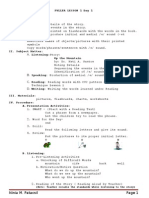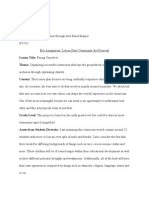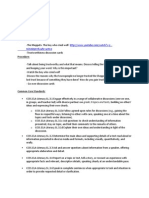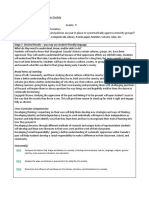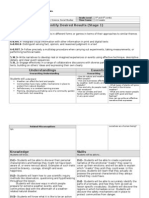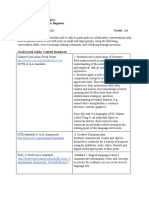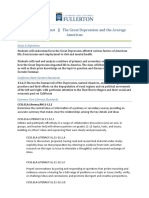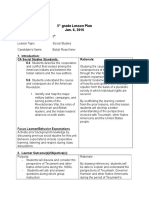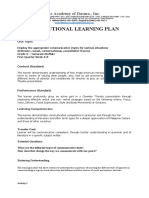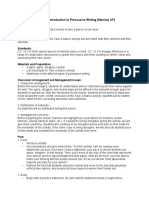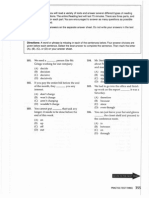0 ratings0% found this document useful (0 votes)
157 viewsTerm 4 Convergencechartmayeseisenberg 2
Term 4 Convergencechartmayeseisenberg 2
Uploaded by
api-309968556This document outlines the curriculum for a unit on the relationship between humans and animals. It includes the relevant standards, curriculum materials, teaching methods, theories of teaching and learning, and context about the students and school. The unit will use a balanced literacy approach including read alouds, partner reading, and independent reading. It will incorporate a debate, gallery walk, group discussions, and presentations to engage students. Differentiation and the workshop model will be used to ensure all students can access higher-order thinking.
Copyright:
© All Rights Reserved
Available Formats
Download as PDF, TXT or read online from Scribd
Term 4 Convergencechartmayeseisenberg 2
Term 4 Convergencechartmayeseisenberg 2
Uploaded by
api-3099685560 ratings0% found this document useful (0 votes)
157 views1 pageThis document outlines the curriculum for a unit on the relationship between humans and animals. It includes the relevant standards, curriculum materials, teaching methods, theories of teaching and learning, and context about the students and school. The unit will use a balanced literacy approach including read alouds, partner reading, and independent reading. It will incorporate a debate, gallery walk, group discussions, and presentations to engage students. Differentiation and the workshop model will be used to ensure all students can access higher-order thinking.
Original Title
term4convergencechartmayeseisenberg2
Copyright
© © All Rights Reserved
Available Formats
PDF, TXT or read online from Scribd
Share this document
Did you find this document useful?
Is this content inappropriate?
This document outlines the curriculum for a unit on the relationship between humans and animals. It includes the relevant standards, curriculum materials, teaching methods, theories of teaching and learning, and context about the students and school. The unit will use a balanced literacy approach including read alouds, partner reading, and independent reading. It will incorporate a debate, gallery walk, group discussions, and presentations to engage students. Differentiation and the workshop model will be used to ensure all students can access higher-order thinking.
Copyright:
© All Rights Reserved
Available Formats
Download as PDF, TXT or read online from Scribd
Download as pdf or txt
0 ratings0% found this document useful (0 votes)
157 views1 pageTerm 4 Convergencechartmayeseisenberg 2
Term 4 Convergencechartmayeseisenberg 2
Uploaded by
api-309968556This document outlines the curriculum for a unit on the relationship between humans and animals. It includes the relevant standards, curriculum materials, teaching methods, theories of teaching and learning, and context about the students and school. The unit will use a balanced literacy approach including read alouds, partner reading, and independent reading. It will incorporate a debate, gallery walk, group discussions, and presentations to engage students. Differentiation and the workshop model will be used to ensure all students can access higher-order thinking.
Copyright:
© All Rights Reserved
Available Formats
Download as PDF, TXT or read online from Scribd
Download as pdf or txt
You are on page 1of 1
Knowledge of Students and Context:
Standards:
Curriculum Materials:
Literacy: CC.1.2.3.D Explain the point of view of the author.
CC.1.2.3.L Read and comprehend literary non-fiction and
informational text on grade level, reading independently and
proficiently. CC.1.2.3.A Determine the main idea of a text;
recount the key details and explain how they support the main
idea. CC.1.2.3.C Explain how a series of events, concepts, or
steps in a procedure is connected within a text, using language
that pertains to time, sequence, and cause/effect.
- Changing the World: Persuasive Speeches,
Petitions, and Editorials, Lucy Calkins
- Every Living Thing, Cynthia Rylant
- Famous Animals, Susan Brocker
- American Zoo Association
- Cass Becomes a Star, Graham Meadows
- A Dog Movie Star Demonstrates the Art of
Canine Acting, youtube.com
- Save the Birds, Fay Robinson
- Aero and Officer Mike, Joan Plummer
Russell, from the Storytown anthology
- Canine Partners for Life
- USDA Animal Welfare Information Center
- Native American Animal Stories, Joseph
Bruchac
- Fireflies, Julia Brinckloe
Writing-- CC.1.4.3.G Write opinion pieces on familiar topics or
texts; CC.1.4.3.H Introduce the topic and state an opinion on the
topic; CC.1.4.3.I Support an opinion with reasons; Create an
organizational structure that includes reasons linked in a logical
order with a concluding statement or section; CC.1.4.3.K Use a
variety of words and sentence types to appeal to the audience;
CC.1.4.3.L Demonstrate a grade-appropriate command of the
conventions of standard English grammar, usage, capitalization,
punctuation, and spelling. CC.1.4.3.X Write routinely over
extended time frames (time for research, reflection, and revision)
and shorter time frames (a single sitting or a day or two) for a
range of discipline-specific tasks, purposes, and audiences.
Speaking and Listening-- CC.1.5.3.A Engage effectively in a
range of collaborative discussions on grade level topics and
texts, building on others ideas and expressing their own clearly.
Social studies-- 5.2.3.A. Identify personal rights and
responsibilities; 5.2.3.C. Identify leadership and public service
opportunities in the school, community, state, and nation;
5.2.3.D. Describe how citizens participate in school and
community activities.
What
The Relationship
Between Humans
and Animals
Why
We will use a variety of teaching methods to
engage our students and reach all different types
of learners:
- Read alouds, partner reading, shared reading,
and independent reading will touch on all parts of
the balanced literacy framework
- The debate and gallery walk will encourage
student inquiry and meaning making
- Small group and whole class discussion will
provide space for students to share their ideas
and learn from each other
- Presentations will build students speaking and
listening skills
Theories of Teaching and
Learning:
How
Teaching Methods:
- Penn Alexander is one of the best schools in
SDP, and our students have consistently high
scores on standardized tests
- A few students are ELL, have IEPs, or just
need more support
- Students are interested in animals, evidenced
by their choice of informational text writing
topics, their I Have a Dream statements, their
Big Money responses, and countless
conversations with students about their pets
- Students have background knowledge
of/personal experience with animals
- Students are accustomed to engaging in
higher-order thinking, are aware of social
issues, and display an interest in tackling
nuanced topics
- Topic is consistent with 3rd grade curriculum
progression and state standards
Educational Philosophy and Beliefs:
- Students should learn from each other, challenge each
other, and engage in meaningful conversation
- Differentiation should be used to accomplish equity
- Education should teach students to see things from
different perspectives and understand nuance
- Students should have an active role in the knowledgebuilding process
- Education should foster empathy and compassion
- Teaching should inspire a sense of initiative within
students, and should give students a significant (but
developmentally appropriate) level of agency and
responsibility
- Teaching and learning should be an enjoyable
experience!
- Calkins theory of teaching/learning
writing: emphasis on a writing process
where students create an argument,
evaluate available evidence, and use the
workshop model to plan and revise their
work
- Tomlinson: differentiation is a way to
ensure that all students are given the tools
they need to access higher-order thinking
- Gardners theory of multiple intelligences:
incorporate a variety of activities and
teaching methods so that each student can
access deep learning and effectively
demonstrate their understanding
- Gilles: importance of group work and
collaboration; students use each other as
resources in the knowledge-building
process
- Scardamalia & Bereiter: learning as an
iterative process of inquiry and implicit
knowledge development
You might also like
- Barumbi Kids UnitDocument7 pagesBarumbi Kids Unitapi-243600639100% (2)
- Ubd Lesson Plan Template: Vital InformationDocument4 pagesUbd Lesson Plan Template: Vital Informationapi-322101445No ratings yet
- Madeline Decker - Ci 403 - Just Mercy Unit Lesson PlansDocument35 pagesMadeline Decker - Ci 403 - Just Mercy Unit Lesson Plansapi-355737575No ratings yet
- Fuller Lesson 1 Day 1Document4 pagesFuller Lesson 1 Day 1Mam Ninz92% (71)
- Ucla 426Document5 pagesUcla 426api-241800671No ratings yet
- Sharingtheplanet 8-12upDocument4 pagesSharingtheplanet 8-12upapi-147600993No ratings yet
- Tkam MypDocument5 pagesTkam Mypapi-300759812100% (1)
- Trivium Subjects Method Skills PDFDocument9 pagesTrivium Subjects Method Skills PDFSwanKnightNo ratings yet
- Introduction To Children's LiteratureDocument12 pagesIntroduction To Children's LiteratureJoanne Lian Li FangNo ratings yet
- SRADocument3 pagesSRAJhondriel LimNo ratings yet
- Action ResearchDocument30 pagesAction Researchapi-252340934No ratings yet
- Equity Key AssignmentDocument9 pagesEquity Key Assignmentapi-561651966No ratings yet
- StrategiesDocument5 pagesStrategiesmargaretNo ratings yet
- 3rd GRD Trustworthy LessonDocument2 pages3rd GRD Trustworthy Lessonapi-242270654No ratings yet
- First Nations Justice UnitDocument17 pagesFirst Nations Justice UnitmrichardburgessNo ratings yet
- Professional Growth PortfolioDocument18 pagesProfessional Growth PortfolioCarla MyskoNo ratings yet
- Just Food? Investigating Food Justice and Culture The Unit Scope and SequenceDocument7 pagesJust Food? Investigating Food Justice and Culture The Unit Scope and Sequenceapi-283715293No ratings yet
- Coleman Ted635 Lessonplan - This OneDocument12 pagesColeman Ted635 Lessonplan - This Oneapi-320426519100% (1)
- Task 4Document15 pagesTask 4api-297195449No ratings yet
- 4 LessonDocument3 pages4 Lessonapi-394663399No ratings yet
- Lesson Plan 5Document3 pagesLesson Plan 5api-335570406No ratings yet
- Artifact #3: Social Studies Lesson Plan: Msed Elementary Portfolio ProjectDocument64 pagesArtifact #3: Social Studies Lesson Plan: Msed Elementary Portfolio Projectapi-469629280No ratings yet
- Lesson 3 FinalDocument9 pagesLesson 3 Finalapi-341879039No ratings yet
- Convergence ChartDocument3 pagesConvergence Chartapi-242601706No ratings yet
- Civics Lesson PlanDocument8 pagesCivics Lesson Planapi-309745875No ratings yet
- Aldridge - Itec 7400 El FinalDocument13 pagesAldridge - Itec 7400 El Finalapi-677307401No ratings yet
- Lesson 2Document5 pagesLesson 2api-720960934No ratings yet
- Iroquois Longhouse Research ProjectDocument4 pagesIroquois Longhouse Research Projectapi-251666799No ratings yet
- Ubd Unit PlanDocument32 pagesUbd Unit Planapi-469833896No ratings yet
- Identify Desired Results (Stage 1) Content Standards: and TopicsDocument6 pagesIdentify Desired Results (Stage 1) Content Standards: and Topicsapi-229802853No ratings yet
- Multicultural Literature Lesson Plan 1Document4 pagesMulticultural Literature Lesson Plan 1Tammy DanielsNo ratings yet
- Social Studies Unit PlanDocument28 pagesSocial Studies Unit Planapi-541678284No ratings yet
- 3rd Grade Friends LessonDocument2 pages3rd Grade Friends Lessonapi-242270654No ratings yet
- How We Express OurselvesrevisedDocument5 pagesHow We Express Ourselvesrevisedapi-147600993No ratings yet
- Sapere 1: Pathfinder URLDocument13 pagesSapere 1: Pathfinder URLballcoach76No ratings yet
- Multi Cultural Literature Unit PlanDocument21 pagesMulti Cultural Literature Unit Planapi-252047277100% (1)
- Genre Project Unit PlanDocument45 pagesGenre Project Unit Planapi-242273696No ratings yet
- Edu 305 Team Teach ProjectDocument9 pagesEdu 305 Team Teach Projectapi-345589793No ratings yet
- 3rd GRD Confidence LessonDocument2 pages3rd GRD Confidence Lessonapi-242270654No ratings yet
- Amazon Rainforest PresentationDocument21 pagesAmazon Rainforest Presentationapi-256807595No ratings yet
- Artifact 2 Multicultural Lesson Activity AssignmentDocument5 pagesArtifact 2 Multicultural Lesson Activity Assignmentapi-633267368No ratings yet
- Academic Outcomes Lesson PlansDocument6 pagesAcademic Outcomes Lesson Plansapi-524951406No ratings yet
- 900 MWF SyllabusDocument17 pages900 MWF Syllabusapi-288178262No ratings yet
- Final LessonDocument3 pagesFinal Lessonapi-300649730No ratings yet
- Lesson Plan Profile A Country 1Document3 pagesLesson Plan Profile A Country 1api-479660639No ratings yet
- Humanities 105-50-5323 Humanities in Global Culture Syllabus Fall 2024Document13 pagesHumanities 105-50-5323 Humanities in Global Culture Syllabus Fall 2024carol stewartNo ratings yet
- Pioneer LessonDocument8 pagesPioneer Lessonapi-340407741No ratings yet
- Udl Lesson Plan For WebsiteDocument19 pagesUdl Lesson Plan For Websiteapi-578964781No ratings yet
- Previous Exam Answers ENG1502Document6 pagesPrevious Exam Answers ENG1502Tshilas33% (3)
- Unit Plan Eddi 520Document33 pagesUnit Plan Eddi 520api-223422713No ratings yet
- Lesson Plan Discussion Great Depressions Effects On Peoples Lives 1Document5 pagesLesson Plan Discussion Great Depressions Effects On Peoples Lives 1api-399893476No ratings yet
- Portfolio Post Observation 2Document4 pagesPortfolio Post Observation 2api-279291777No ratings yet
- Previous Exam AnswersDocument6 pagesPrevious Exam AnswersCharmaine Verrall97% (36)
- Lesson 7 Outsiders CH 5Document14 pagesLesson 7 Outsiders CH 5api-349579702No ratings yet
- 5 Grade Lesson Plan Jan. 6, 2016: CA Social Studies Standards: 5.3 Students Describe The Cooperation RationaleDocument5 pages5 Grade Lesson Plan Jan. 6, 2016: CA Social Studies Standards: 5.3 Students Describe The Cooperation Rationaleapi-305432838No ratings yet
- Social Justice Lesson PlanDocument9 pagesSocial Justice Lesson Planapi-350131256No ratings yet
- Lesson Plan Day 1Document4 pagesLesson Plan Day 1api-317730714No ratings yet
- Syllabus Space Place and MemoryDocument7 pagesSyllabus Space Place and Memoryapi-390149547No ratings yet
- Respect Lesson Plan (ELA)Document4 pagesRespect Lesson Plan (ELA)Brittany DesRochesNo ratings yet
- Black History Month LessonDocument11 pagesBlack History Month LessonJ JohnsonNo ratings yet
- 10th Grade Unit Plan: Perfecting The Art of Persuasion-What Is The American Dream?Document11 pages10th Grade Unit Plan: Perfecting The Art of Persuasion-What Is The American Dream?api-237174033No ratings yet
- Institutional Learning Plan: Oxford Louise Academy of Dasma., IncDocument2 pagesInstitutional Learning Plan: Oxford Louise Academy of Dasma., IncBong ReloxNo ratings yet
- First LessonDocument3 pagesFirst Lessonapi-300649730No ratings yet
- The Challenges of Culture-based Learning: Indian Students' ExperiencesFrom EverandThe Challenges of Culture-based Learning: Indian Students' ExperiencesNo ratings yet
- Term 4 Lesson Plan 3Document3 pagesTerm 4 Lesson Plan 3api-309968556No ratings yet
- Term 4 Lesson Plan 2Document3 pagesTerm 4 Lesson Plan 2api-309968556No ratings yet
- Term 4 Lessonplan 3Document3 pagesTerm 4 Lessonplan 3api-309968556No ratings yet
- Term 4 Lessonplan 1Document3 pagesTerm 4 Lessonplan 1api-309968556No ratings yet
- Term 4 NotesDocument2 pagesTerm 4 Notesapi-309968556No ratings yet
- Resource Medium Annotation Strengths & Limitations Day 1 (3/7)Document7 pagesResource Medium Annotation Strengths & Limitations Day 1 (3/7)api-309968556No ratings yet
- Flesch-Kincaid Grade LevelDocument2 pagesFlesch-Kincaid Grade LevelHamidreza AbdiNo ratings yet
- LAC Session Guide (Online) - Raising Learner - S Phonological Awareness As Foundational Skill To DecodingDocument7 pagesLAC Session Guide (Online) - Raising Learner - S Phonological Awareness As Foundational Skill To DecodingJhe AzañaNo ratings yet
- Topic - 7 Action ResearchDocument16 pagesTopic - 7 Action ResearchNora AyuniNo ratings yet
- What Is The (RI) Reading Inventory?Document1 pageWhat Is The (RI) Reading Inventory?Anonymous xNMmlQlNo ratings yet
- Speaking For Academic Purposes: Ayu Latifah (2520170014) Aulia Nuradha (2520170009)Document10 pagesSpeaking For Academic Purposes: Ayu Latifah (2520170014) Aulia Nuradha (2520170009)ayu latifahNo ratings yet
- Artikel Jurnal - Nanda Rizki F - 150311606931Document10 pagesArtikel Jurnal - Nanda Rizki F - 150311606931Nanda FitriarifliNo ratings yet
- Cloze Test PowerPointDocument14 pagesCloze Test PowerPointsetdangNo ratings yet
- PTE JainDocument17 pagesPTE JainsjkhappsNo ratings yet
- Lesson Plan CEFR (HEBAT Bacaan)Document3 pagesLesson Plan CEFR (HEBAT Bacaan)Nisa Halim100% (3)
- Understanding SAT Scores 2018 PDFDocument10 pagesUnderstanding SAT Scores 2018 PDFHo Yiu YinNo ratings yet
- Teks BiografiDocument4 pagesTeks BiografiElmira MiraNo ratings yet
- Antunez (2002)Document10 pagesAntunez (2002)Keith WheelerNo ratings yet
- Balogo HS LRPDocument18 pagesBalogo HS LRPCherry AbrazadoNo ratings yet
- Study and Thinking Skills - SyllabusDocument3 pagesStudy and Thinking Skills - Syllabusjedcee21No ratings yet
- Making Predictions Lesson Plan 2Document6 pagesMaking Predictions Lesson Plan 2api-340734697100% (2)
- Erac - Early - Reading - Assessment - Checklist - Grade - 2 - Mar2012 - Master - 8 and 9Document2 pagesErac - Early - Reading - Assessment - Checklist - Grade - 2 - Mar2012 - Master - 8 and 9Anabelle Gines ArcillaNo ratings yet
- 7th RDG Syllabus Dotx 15-16Document3 pages7th RDG Syllabus Dotx 15-16api-292045124No ratings yet
- Lesson 3: Emergent LiteracyDocument11 pagesLesson 3: Emergent LiteracyMs. aZiaNo ratings yet
- Longman Intermediate Test 3 ReadingDocument26 pagesLongman Intermediate Test 3 Readingkimhoaihan_690223798No ratings yet
- 40 Free Fonts PreviewDocument41 pages40 Free Fonts PreviewLuis RetaNo ratings yet
- Super Minds Level2 Students Book With DVD Rom Table of ContentsDocument2 pagesSuper Minds Level2 Students Book With DVD Rom Table of Contentsdaniel50% (2)
- SPM Directed WritingDocument11 pagesSPM Directed WritingAnonymous klhru5ENo ratings yet
- R & L Q2 With TOS FINALEDocument6 pagesR & L Q2 With TOS FINALEJessly Dulce CuizonNo ratings yet
- Francine Poulet Meets The Ghost Raccoon Teachers' GuideDocument7 pagesFrancine Poulet Meets The Ghost Raccoon Teachers' GuideCandlewick PressNo ratings yet
- Vocabulary Acquisition Paul Nation 1989Document139 pagesVocabulary Acquisition Paul Nation 1989juanhernandezloaizaNo ratings yet
- 157 340 Admin Guide 2017Document47 pages157 340 Admin Guide 2017Vineet KaranNo ratings yet



